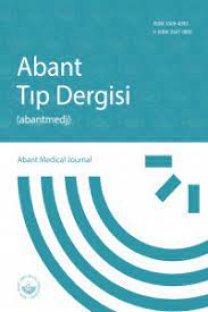Serebral Lateralizasyon, Koroner Arter Hastalığı, Koroner Arter Anomalileri ve Koroner Arter Baskınlığı Arasındaki İlişki
Cerebral lateralization, Coronary Artery Disease, Coronary artery dominance, Coronary artery anomaly, Serebral lateralizasyon, Koroner Arter Hastalığı, Koroner arter baskınlığı, Koroner arter anomalisi
Relationship Between Cerebral Lateralization, Coronary Artery Disease, Coronary Artery Anomalies and Coronary Arterial Dominance
Cerebral lateralization, Coronary Artery Disease, Coronary artery dominance, Coronary artery anomaly,
___
- 1. Friedman MH, Baker PB, Ding Z, Kuban BD. Relationship between the geometry and quantitative morphology of the left anterior descending coronary artery. Atherosclerosis. 1996;125(2):183–92. doi: 10.1016/0021-9150(96)05869-8.
- 2. Friedman MH, Brinkman AM, Qin JJ, Seed WA. Relation between coronary artery geometry and the distribution of early sudanophilic lesions. Atherosclerosis. 1993;98(2):193–9. doi: 10.1016/0021-9150(93)90128-h.
- 3. Fisher M, Fieman S. Geometric factors of the bifurcation in carotid atherogenesis. Stroke. 1990;21(2):267–71. doi: 10.1161/01.str.21.2.267.
- 4. Nguyen ND, Haque AK. Effect of hemodynamic factors on atherosclerosis in the abdominal aorta. Atherosclerosis. 1990;84(1):33–9. doi: 10.1016/0021-9150(90)90005-4.
- 5. Zhu H, Ding Z, Piana RN, Gehrig TR, Friedman MH. Cataloguing the geometry of the human coronary arteries: a potential tool for predicting risk of coronary artery disease. Int J Cardiol. 2009;135(1):43-52. doi: 10.1016/j.ijcard.2008.03.087. Epub 2008 Jul 1.
- 6. Yoon BW, Morillo CA, Cechetto DF, Hachinski V. Cerebral hemispheric lateralization in cardiac autonomic control. Arch Neurol. 1997;54(6):741-4. doi:10.1001/archneur.1997.00550180055012
- 7. Coren S, Halpern DF. Left-handedness: a marker for decreased survival fitness. Psychol Bull. 1991;109(1):90-106. doi: 10.1037/0033-2909.109.1.90.
- 8. Bryden PJ, Bruyn J, Fletcher P. Handedness and health: an examination of the association between different handedness classifications and health disorders. Laterality. 2005;10(5):429-40. doi: 10.1080/13576500442000193.
- 9. Elias LJ, Saucier DM, Guylee MJ. Handedness and depression in university students: a sex by handedness interaction. Brain Cogn. 2001;46(1-2):125-9.
- 10. Smith J. Left-handedness: its association with allergic disease. Neuropsychologia. 1987;25(4):665-74. doi: 10.1016/0028-3932(87)90057-1.
- 11. Ghchime R, Benjelloun H, Kiai H, Belaidi H, Lahjouji F and Ouazzani R. Cerebral Hemispheric Lateralization Associated with Hippocampal Sclerosis May Affect Interictal Cardiovascular Autonomic Functions in Temporal Lobe Epilepsy. Epilepsy Res Treat. 2016;2016:7417540. doi: 10.1155/2016/7417540. Epub 2016 Feb 24.
- 12. Von Lüdinghausen M. The clinical anatomy of coronary arteries. Adv Anat Embryol Cell Biol.. 2003;167:III-VIII, 1-111.
- 13. Celik T, Iyisoy A, Kursaklioglu H, et al. Does coronary artery size really matter? Echocardiogr-J Card. 2005;22(6):479-86
- 14. Yetkin E and Waltenberger J. Novel insights into an old controversy: is coronary artery ectasia a variant of coronary atherosclerosis? Clin Res Cardiol. 2007;96(6):331-39. doi: 10.1007/s00392-007-0521-0.
- 15. Demirbag R, and Yilmaz R. Effects of the shape of coronary arteries on the presence, extent, and severity of their disease. Heart Vessels. 2005; 20(5):224-29. doi: 10.1007/s00380-005-0837-5.
- 16. Oldfield RC. The assesment and analysis of handedness: The Edinburgh Inventory. Neuropsychologia. 1971;9(1): 97-113. doi: 10.1016/0028-3932(71)90067-4.
- 17. Tan U, Caliskan S. Allometry and asymmetry in the dog brain: right hemisphere is heavier regardless of paw preference. Inf J Neurosci. 1987;35(3-4):189-94. doi: 10.3109/00207458708987127.
- 18. Geschwind N, Galaburda AM. Cerebral lateralization. Biological mechanisms, associations, and pathology: I. A hypothesis and a program for research. Arch Neurol. 1985;42(5):428-59. doi: 10.1001/archneur.1985.04060050026008.
- 19. Milenković S, Belojević G, Kocijancić R. Aetiological factors in left-handedness. Srp Arh Celok Lek. 2005;133(11-12):532-4. doi: 10.2298/sarh0512532m.
- 20. Cole J. Paw preferences in cats related to hand preferences in animals and men. J Comp Physiol Psychol. 1955;48(2):137-40. doi: 10.1037/h0040380.
- 21. Annett M. The distribution of manual asymmetry. Br J Psychol. 1972;63(3):343-58. doi:10.1111/j.2044-8295.1972.tb01282.x.
- 22. Raymond M, Pontier D, Dufour AB, Moller AP. Frequency-dependent maintenance of left handedness in humans. Proc Biol Sci. 1996;263(1377):1627–33. doi:10.1098/rspb.1996.0238.
- 23. Foster PS, Hubbard T, Yung RC, et al. Cerebral asymmetry in the control of cardiovascular functioning: Evidence from lateral vibrotactile stimulation. Laterality. 2013;18(1):108-19. doi: 10.1080/1357650X.2011.631545. Epub 2012 Jan 30.
- 24. Lane RD, Caruso AC, Brown VL, et al. Effects of non-right-handedness on risk for sudden death associated with coronary artery disease. Am J Cardiol. 1994;74(8):743-7. doi: 10.1016/0002-9149(94)90426-x.
- 25. Roy B, Woo M, Kumar R. Cerebral blood flow in the central autonomic network: is there any effect of hemispheric lateralization in patients with heart failure? Reply. Eur J Heart Fail. 2018 ;20(4):830-1. doi: 10.1002/echo.1033. Epub 2017 Oct 18.
- Yayın Aralığı: Yılda 6 Sayı
- Başlangıç: 2012
- Yayıncı: Bolu Abant İzzet Baysal Üniversitesi Tıp Fakültesi Dekanlığı
Fournier Gangreninde Cerrahi Tedavi Sonuçlarımız:Tek Merkez Deneyim
Serkan ERKAN, Hakan YABANOĞLU, Ramazan GÜNDOĞDU, Murat KUŞ
Osman YAKŞİ, Akif TURNA, Ezel ERSEN, Zeynep TURNA, Kamil KAYNAK
Recep ALANLI, Murat Bülent KÜÇÜKAY, Serkan YALÇIN
Transfüzyon İlişkili İstenmeyen Reaksiyonların 7 Yıllık Retrospektif Analizi: Tek Merkez Deneyimi
Uterus Adenosarkomları: On Üç Olgunun Klinikopatolojik Değerlendirmesi
Duygu AYAZ, Sevil SAYHAN, Dudu SOLAKOĞLU KAHRAMAN, Volkan KARATAŞLI
Serkan ZENGER, Bülent GÜRBÜZ, Uğur CAN, Çağrı BİLGİÇ, Erman SOBUTAY, Orhan BİLGE
4. Kuşak HIV ELISA Eşik Değerleri ile Doğrulama Test Sonuçlarının Birlikte Değerlendirilmesi
Emine TÜRKOĞLU, Sedef Zeliha ÖNER
Gözden Kaçan Olgularda Kedi Tırmığı Hastalığı
Pinar SIRMATEL BUCUK, Asuman KİLİTCİ, Fatma SIRMATEL
Songül ARAÇ, Yılmaz ZENGİN, Mustafa İÇER, Ercan GÜNDÜZ, Recep DURSUN, Hasan DURGUN, Mehmet ÜSTÜNDAĞ, Murat ORAK, Mahir KUYUMCU, Cahfer GÜLOĞLU
